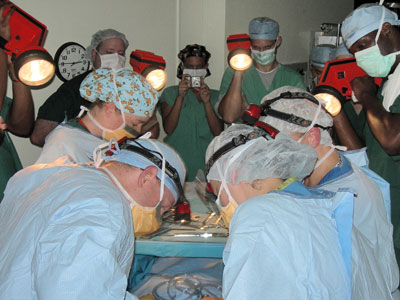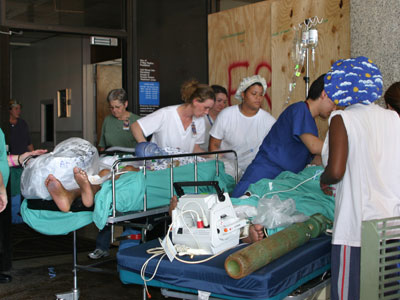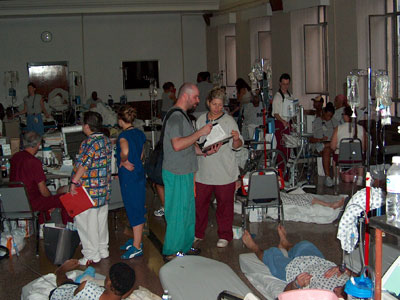
The employees of the Medical Center of Louisiana at New Orleans (MCLNO) met the horrific suffering and destruction that Katrina wrought on August 29, 2005, with the highest professionalism and heroic behavior.
With patients’ lives, and their own, in the balance for days, they were cut off by flood waters from assistance of any sort. But the doctors, nurses, administrators, allied health, security, maintenance, and support personnel of MCLNO’s Charity and University hospitals stood fast by their patients, improvised when power failed, food ran short, and gunfire erupted.
The disaster engulfed the personal lives of employees as well. Flooding and tornadic winds destroyed their homes, scattered their families across the nation, and created mayhem that few before had ever seen. Yet, immediately after the evacuation of patients from MCLNO to other hospitals of the LSU Health Care Services Division, employees were formulating plans for the renewal of healthcare in greater New Orleans.

On September 29, 2005, LSU re-established hospital and trauma care in the city on the USNS Comfort, a U.S. Navy hospital ship. On October 12, LSU opened in a parking lot, beside the severely damaged University Hospital, “The Spirit of Charity,” a MASHlike mobile tent hospital, which moved three weeks later into Hall J of the Ernest N. Morial Convention Center.
The aptly named “Spirit of Charity” reflected LSU HCSD employees’ spirit of commitment to their profession, community, and citizens of Louisiana. When many, under far less duress, would have walked away, the employees of LSU Hospitals stepped forward.
The hospital would move once more, a few blocks away, to the Lord & Taylor Department Store location, where it would remain until the reopening of University Hospital in November 2006, under its new name, the Interim LSU Public Hospital.
This reopening immediately provided eighty-five beds for the highest level of primary and specialty care and topnotch education for students in the health professions. The hospital began offering most of the services that were available at the MCLNO before the storm.

The reopening of this hospital was not simply an unlocking of the doors. The hospital received significant improvements. The hospital has two 64-slice CT scanners and a 3T MRI, which offers the latest magnetic resonance imaging available. The hospital is wireless. Doctors have access to the electronic file cabinet in any hospital computer. The critically ill may not be able to tell a physician crucial information and now won’t have to. A few keystrokes will deliver it.
The enduring commitment of LSU staff continued in the weeks and months that followed Katrina, despite the threat of Hurricane Rita in September 2005. This tenacious storm sideswiped New Orleans while it barreled to southwest Louisiana, where it would create another formidable challenge for LSU Hospitals.
Nevertheless, primary care, dermatology, neurology, and podiatry clinics reopened in the Hutchinson Building on Tulane Avenue in October 2005. The Maternal Child Services Clinic reopened on Perdido Street on August 29, 2006, the one-year anniversary a fitting date for its return. In its first month, clinic staff saw over 300 patients; in its second, they saw 476. By this time, the return of the population had clearly indicated the need for healthcare, and the rebirth of LSU Hospitals was well underway. Also, cardiology, congestive heart failure, and infectious disease clinics reopened on South Roman Street, where LSU would also provide dental care.

In February 2007, LSU moved its trauma center from Elmwood Medical Center in Jefferson Parish, where it relocated shortly after Katrina, to the Interim LSU Public Hospital, a move that added fifty more beds and re-established this nationally preeminent trauma center downtown near the medical schools.
With the immense destruction of homes and entire neighborhoods in New Orleans, LSU had far fewer employees, but it flipped this adversity to its advantage.
It has long used telemedicine in some specialties and in the provision of healthcare to correctional facilities. To address the shortage of specialists, LSU expanded its use of telemedicine, which employs high-resolution cameras, the electronic transmission of patient records, and advanced stethoscopes, to psychiatry, ophthalmology, neurology, dermatology, and cardiology.
This technology can allow a specialist to hear a patient’s heart beat though the specialist is miles away from the patient. LSU Telemedicine is improving patient care and introducing new efficiencies into the healthcare system.